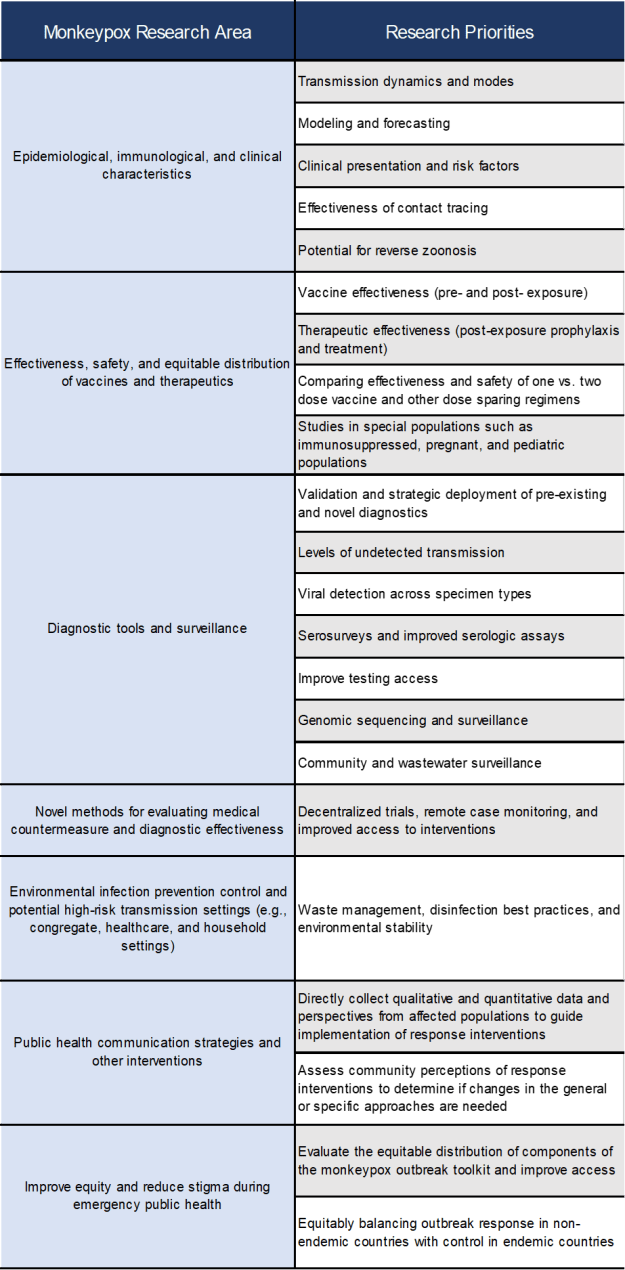U.S. Monkeypox Research Priorities: Speeding Science for Impact
By Dr. Alondra Nelson, head of the White House Office of Science and Technology Policy and Deputy Assistant to the President
Dr. Matthew Hepburn, Senior Advisor to the OSTP Director on Pandemic Preparedness
Dr. Anastasia S. Lambrou, OSTP Senior Policy Advisor for Pandemic Prevention
The monkeypox outbreak has impacted more than 70 countries to date and has led to more than 15,000 infections, including over 2,300 in the United States. It’s not a new disease – and it’s one for which we have treatment. But there are differences from prior outbreaks.
Today, the U.S. Government has laid out a clear set of research priorities to address this outbreak.
Led by the White House Office of Science and Technology Policy (OSTP), the Monkeypox Research Priorities Team, comprised of experts from across the U.S. Government, outlined a research plan to speed science and enable the U.S. and global monkeypox outbreak response.
This collaborative, whole-of-government effort complements other global activities such as the World Health Organization’s Monkeypox R&D Blueprint and the United Kingdom Health Security Agency’s research and evidence gaps prioritization analysis.
While the United States has rapidly scaled its efforts to deliver tests, treatments, and vaccines to impacted individuals in the U.S., these monkeypox research priorities will enable us to gain a better understanding of the virus and what will work best to stop the outbreak. The priorities will also guide the broader global scientific community.
The following list prioritizes the difficult questions that have arisen during this outbreak. For example, while vaccines, therapeutics, and diagnostics exist that can help prevent, detect, and treat monkeypox, more research is needed to help determine the best use of these products. There are additional questions about how long people will be sick, and why some people become more ill than others. The current outbreak seems to be different than prior outbreaks of monkeypox, raising questions about how people get infected, virus changes, detection in various specimen types, and risk factors for becoming sick.
The response to an outbreak should ensure everyone can be protected. The knowledge gained from this research must benefit everyone, not only within the United States, but also in endemic and non-endemic countries globally. A successful response requires education, outreach, trust-building, and community buy-in. Therefore, ongoing assessment of the effectiveness of communications and response efforts is required to further refine outbreak response approaches.
Leveraging ongoing efforts and agency collaboration, the U.S. Government has identified $140 million to support high-priority projects such as serosurveys, epidemiological and clinical observational studies, molecular epidemiology, ecological studies, global trainings, and early-stage medical countermeasure development. Further efforts are needed, however, to fill critical gaps such as vaccine and treatment studies, assessing viral detection in different fluids and parts of the body, evaluating viral viability in various environments, and human transmission studies.
The interagency Team identified the following seven research focus areas and priorities in each area:
U.S. Monkeypox Research Priorities (July 2022)

Because outbreaks are dynamic, these monkeypox research priorities will be consistently revisited and refined to reflect the current stage of the outbreak and emerging response needs.
###
